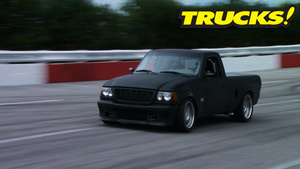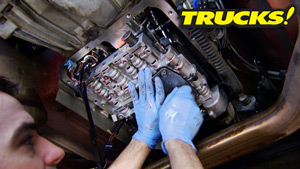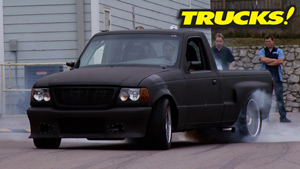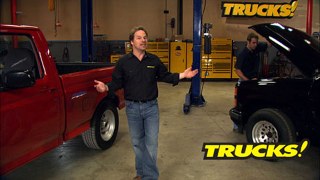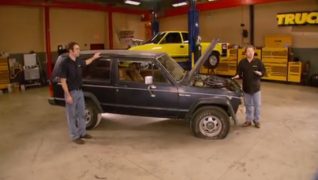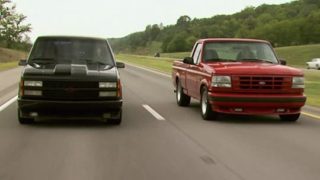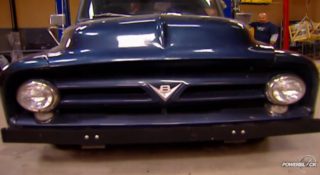More "MuscleTrux Wars" - '90 Chevy 454 SS vs. '94 Ford Lightning Episodes
Trucks! Builds
Want more content like this?
Join the PowerNation Email NewsletterParts Used In This Episode
American Racing
18X8 Polished Torq-Thrust II, 18X10 Polished Torq-Thrust II, 5x5 B.C. 4.5" B.S.
Dunne-Rite Performance LLC
Mass Air Flow Conversion with stand-alone engine controller.
Dynojet Research
Chassis dyno.
DynoSpeed Racing, Inc.
Assisted with tuning and calibrations with SCT Flash software.
Edelbrock
Pro-Flo EFI setup with manifold and calibration chip upgraded to Pro-Flo 2, hydraulic roller lifters, hydraulic roller camshaft, exhaust headers, gasket kit set, timing set, head bolts, intake bolts, heat treated pushrods, aluminum cylinder heads.
Goodguys Rod and Custom Association
The Goodguys Rod & Custom Association promotes and produces some of the world's most dynamic automotive events.
Goodmark Industries
Steel cowl induction hood.
Holley
255 LPH Forced Induction electric in-tank pump EFI.
Mothers Polish
Mother's Professional Compounds, Heavy duty rubbing compound, Foam polishing pads, Machine glaze, Hand glaze.
MSD Ignition
MSD 6-A ignition box.
Optima
Optima Yellow Top battery.
Robert Bosch LLC
Aftermarket fuel injector set.
SCT Flash
Pro Racer 3.0 key kit, USB chip programmer, four program four bank chip, SCT cable only, SCT switch only.
Episode Transcript
Today. More muscle trucks war. It's a chassis,
dyno shoot out to see what kind of power our sport trucks are making.
Then we'll check out what's hot and what's cool at the Nashville good guy show. And finally it's sanding and buffing tech that will give your truck a mirror finish. It's all today here on trucks.
Hey, welcome to trucks and welcome back to our battle of the muscle trucks where we're putting these two factory sport trucks up against each other. And we think we got these trucks looking better than they did when they were brand new with a lowered, much more aggressive stance. And although my 94 lightning year was still retains its basic sock outward appearance. Ryan's 454 Ss. Well, it's sporting some classic eye candy with American racing wheels and a good mark cow induction hood. And today we're finally going to get to see what kind of power these trucks are making at the rear wheels. And if the mods we made are going to meet our power goals and in case you're new to this muscle trucks thing. Well, we're going to find out if brute big block power wins the day over a turbocharged small block.
But these build ups, well, they're not just about horsepower because regardless of what we put down to the ground today, later on this season, we've got a real world test, put these trucks up against each other on the road.
Well, today's show is all about tuning and squeezing every last ounce of performance you can out of your truck.
Now, if you like a lot of hot riders and you've been dragged into this modern age of computers, kicking and screaming. Well, custom tuning with a laptop sounds a little intimidating to say the least. But the truth is a lot of computer controlled vehicles on the road today are fairly easy to tap into, to improve performance and efficiency. So we're gonna follow Kevin's lightning over to the horsepower
dyno
and find out just how easy it is and more importantly, see what a great tool a computer can be while tuning any vehicle.
Now, before we even spin the drums on our
dyno Jet, well, we've got to make a few adjustments and changes. Now, the first change we're gonna make is swapping our stock replacement plugs for ones that are one heat range colder. We're also going to close the gap down to about 32 to 35,000 and that'll keep the spark from getting blown out by the turbo boost
along with the spark plug change. We also set the truck's base timing to 10 degrees.
You ready?
Go ahead and give it a call. The lightning was seriously lean
and that can cause detonation and put holes in pistons. So we shut it down,
Julene.
Nah, it's way lane. There's something up.
Well, we got a bit of a lean condition. Well, no worries because we planned all along to have some guys here today to help us dial in the tune on this truck.
So Rick Spur
and Joe Beagle from dyno speed racing in Memphis, Tennessee have come out here to help us dyno tune our lightning using the latest SCT software. Now, Joe Rick, you guys have been down this road before we got a lean condition. What's up with that?
Well, basically, this 94 lightning is being converted over to mass air
and the mass air computer is set up for a, a stock vehicle. It's not set up to see boost and you've added a turbo to the truck, the truck's gonna run lean, it needs more fuel to the, to the tune. Let me
see that thing.
Now, I know we're all used to the tuners, the handheld tuners on all the late model stuff where you can get in and access information, make adjustments. How are you gonna do that on an old style computer like this?
Well, basically we're gonna take an SCT four bank Eliminator chip and using the SCT Advantage three software. We're gonna actually take the tune file here with the modifications that have been done to the truck. We're gonna burn it into the chip via this SCT chip burner.
In order to get to the computer circuit board, Rick opens the case
unscrews the board
and cleans the contact points thoroughly just to make sure there's good signal.
Next, the case gets modified a little to be able to accept the SCT chip
using the SCT software. Joe puts a basic tune into the chip based on the equipment we've installed onto the truck that should get us in the ballpark and the air fuel ratio balanced out
that tune gets burned or programmed into the chip
and then installed onto the circuit board where it gets interpreted by the computer which in turn tells the truck's hardware how to respond.
Now, just for this tuning session, we'll leave our computer right here for easy access.
It's looking a little lean still, isn't it?
Yeah, we definitely need to reprogram the chip and add some fuel. Cool. The laptop showed us that we were still lean as the revs went up.
Dyno speed racing has years of experience and a great reputation for tuning safe and impressive power.
Joe reset the fuel tables and burned another tune into the chip.
Yeah.
Ok. 309.7 it standard correction powers up. How'd the run look,
uh, the, the run looks really good from the time that we started it to about 5100 RPM. S and then the truck starts leaning out again,
so we need to add a little bit more fuel to it.
Go for it. The readout tells us exactly what's going on in the engine at wide open throttle detonation would be impossible to hear what this truck's exhaust. But with the computer you can actually see a lean condition.
Joe adds more fuel up top and hit it again.
Looks like power is about the same, but we're still leaning out just past 5000 RPM. What's going on?
It looks like the truck's not taking the fuel changes that I'm trying to command.
And the way the fuel pressure dropped at the top of the run looks like we may have reached the limits of the in tank fuel pump. So you think we just need to upgrade the in tank pump to like a higher flow unit that take care of it.
Absolutely. Upgrading this truck with an in tank 255 L per hour will give this truck more fuel than it needs
when the truck has the fuel that it needs you
to increase the timing. When you increase the timing, the truck's gonna pick up horsepower and torque cool. So with the pump upgrade, we're safe all the way through the RPM van and we can make more power. That is correct. Sounds like a plan to me. Thanks guys. We appreciate your help today. Yeah, Joe Rick, thanks guys.
Hope you guys didn't make this thing too fast.
Don't worry about him
up next. Ryan's 454 Ss hits the rollers and later we'll truck on over to the good guys show. Stay tuned.
Welcome back to trust.
We're checking the power numbers at the wheels on our 94 lightning that's sporting a stock engine and sts tailpipe turbo.
And even though we found the limits of the stock fuel pump at 5000 RPM,
we made an impressive 310 horsepower at the wheels
over the break. We dropped in a new 255 L per hour fuel pump from Haley. It's specially made for forced induction
and we left the BBK in line pump in place just to make sure we had enough delivery.
That's what I'm talking about, man.
You look pretty happy.
What are the numbers? Tell you what
I'll write them on the tailgate and you can read them at the track. How's that? Oh, yeah,
I get
it. Maybe you ought to write them on the grill instead.
Now that read, they made some decent power.
But I've got high hopes for this big block with Ed
Brock Tap and components.
We get
2 98.5 and 3 36 ft pounds. That ain't bad. Not for the first run. What the air fuel ratio curve look like you're leaning out up top.
Could use a little fattening up around 45 4700,
make
some changes.
So what we're gonna do is add a little bit of fuel across the RPM range at the wide open throttle setting.
And you saw us install their pro flow fuel injection system.
But since then Edelbrock has just released the new pro flow to EF I which gives you even more options that still let you tune for power or economy without a laptop
we get
while you broke 300 horse 3 37 ft pounds, air fuel looks really good. It's still kind of shaky right here. Right under five grand.
Yeah,
I'll do a little more tweaking.
Now. We're still a little lean on the top end. So what we're gonna do is add some more fuel at 5000 RPM.
Well, what's the news, man? You're real consistent powers up a little bit, torques down a little bit, but the air fuel is perfect all the way through. But it, it's kind of shaky around five grand.
It sounds like it started missing close to 5000 RPM. Like a spark was dropping out. Well, let's see if horsepower has got an MST box we can throw on there worth a shot.
We suspected that spark was falling off at high RPM.
So we installed an MS D six A to make sure we had good combustion past 4500 RPM.
Now, while Tommy was under the hood hooking up the MS D box, we noticed one of the plug wire boots was laying on the exhaust, it burned right through the insulation. This thing was arching out.
So we're gonna throw in a new plug wire. See what this thing will do. Firing on all eight.
All right. Well, that sounded better. What is it?
3 18 351 ft pounds and your air fuel? It is perfect all the way up. Sweet. 350. Solid on the torque. 318 on horsepower. Yeah, that's got to be getting close to 400 horse at the crank. Yeah, but parasitic loss. That's right at 400. That's smoking, man.
Yeah, that's a solid 125 over a stock baseline.
It's not too bad
when we come back. Checking out good trucks all built by good guys. Stick around.
Hey, welcome back. Well, guess where we are.
That's right. Good guys, Rod and Custom Nashville Nationals. And uh I don't even know where Ryan and Tommy are, but I'm gonna check out some of these cool vehicles.
Good guys has been around for more than 20 years and with vehicles included up to 1972 there's plenty of variety and plenty of trucks.
Yeah. No parking.
Right.
Check it out. Paul Brees drug this 1940 Chevrolet fire truck out of a Junkyard Pro Street. It extended the cap and check it out appropriately enough. He gave it a flame job.
This is trick.
Now these stains right here. This is not some special custom paid treatment. You gotta check out what made these marks hit it.
That's right. It's a
hemi
this early Ford is sporting all kinds of killer details like chrome straight axle, front end, barely muffled headers, classic big and littles with American racing torque thrust wheels. And let me tell you this truck had everybody's attention
just like a project body bag. We got suicide doors on a classic this time though.
That's cool.
I finally found Tommy and Ryan at the advanced plating facility where we got a chance to meet some of you good guys and hand out a little swag too.
You're welcome.
Hey, check out super softs trick 70
challe. But I guess he parked it on the wrong side of town and somebody needed some left side sheet metal
over in the manufacturer's midway. We saw Boer performances. Latest work Street Rods by Michael was there and Raus performance had a presence as well.
But by far, one of the coolest trucks we saw was this 1944.
This is a true rat rod with emphasis on the rat.
I think he took a cue from our own Tommy Bos
who's on the grill, but this isn't all old truck. This is a functional engine. It looks like a
Hammy, but it's not a
hemi
it's actually a small block Chevy hiding under full valve covers and yes, the air conditioning works and we're seeing a lot of custom classic trucks here, but this one is brand new bumper to bumper with a warranty.
There's no mista
what vehicle Southern Motor company modeled this truck after but with tons of luxury features, more room in the cab, several modern drive train options and yes, you heard me right. A bumper to bumper 336 warranty. This is a much easier way to own a reliable classic with style
all in all. It's plain to see. Good guys puts on a killer car and truck show.
Give me a bag.
All right.
Yeah.
After the break, we'll show you how doing this
and this can lead to this. Don't go away.
Hey, welcome back. Well, with the muscle dialed into the muscle trucks, we can switch gears a little bit. Let's talk about the paint. Now, this SS has had a recent paint job and it looks good, but it showed a little bit of texture. A little bit of orange, peel, nothing wrong with that. It's still nice and glossy. But you've got an opportunity here to really enhance the quality of the reflection and the gloss of the paint job by color sanding and buffing. Now, keep in mind if you've got factory paint, you gotta be a little more careful because you can sand and buff through the paint easier. Ours is an aftermarket paint job, so we're in pretty good shape because they're most of the time thicker.
So we're gonna show you how to color sand and buff your paint job and level out that texture to create a pure reflection with an incredible gloss. We're gonna start out with 1500 grit sandpaper on a six inch D A sander.
Now, just to drive the point home,
I'm gonna tape off half of this panel
so we can really show you
what a difference this makes.
Keeping the D A flat is important and applying light, gentle pressure.
All right. Check it out.
You can really see where the texture and the orange peel is right here. This is almost level and dead flat. We gotta keep going until we don't see any more of these dark spots.
Now, with everything leveled out with the 1500 dry, we're gonna switch to 3000 grit wet
and this time use a little bit of water with it
to lubricate it. So we don't load the pad up.
You'll notice that I'm staying away from the edges and the corners. There's never as much paint build up there and you can easily sand through.
Now, the 3000 grid hardly takes any material off, but it really puts a fine scratch in the surface that gets us ready for
the magic to happen buffet.
Now, you've got a lot of choices when it comes to a compound system to buff the gloss back into your paint job. But a newcomer in this area is mothers with their new professional compound system. Now, I had the chance to use this on project H RT already. And let me tell you what it rocks. The gloss came up quick and you've seen the quality of that paint job.
So we're going to start out with a clean wool pad and their heavy duty compound since this is a cured finish
using about a quarter sized blob of compound and lubricating the surface with a little mist, water start compounding at a slow speed with the pad flat to the surface.
You can see right away the quality of the reflection coming back at you a couple more steps to this. We're going
once your sanding stretches are completely gone and you've cleaned the surface with a microfiber towel. You can switch to the next step, which is a less aggressive black foam pad.
This time, we're using the mother's foam pad, polish.
The second step won't take nearly as long as a compound
after cleaning the residue. The third step is a fine white pad with mother's machine. Glaze
always keep a water mister on hand and Sprit your panel once in a while dry buffing can cause scratches and swirls and they really show up on black.
The last step is a hand glaze on a microfiber towel.
Now, check out what an unbelievable difference color sanding and buffing can make to a panel. This bedside looks like a mirror now and the best thing about this whole process is that this is something it's not that difficult. You guys can do this at home and it's even easier with a high quality product. Like mother's on your side.
It looks like I got a little bit more rubbing to do. Thanks for watching trucks. See you guys next week.
Show Full Transcript
dyno shoot out to see what kind of power our sport trucks are making.
Then we'll check out what's hot and what's cool at the Nashville good guy show. And finally it's sanding and buffing tech that will give your truck a mirror finish. It's all today here on trucks.
Hey, welcome to trucks and welcome back to our battle of the muscle trucks where we're putting these two factory sport trucks up against each other. And we think we got these trucks looking better than they did when they were brand new with a lowered, much more aggressive stance. And although my 94 lightning year was still retains its basic sock outward appearance. Ryan's 454 Ss. Well, it's sporting some classic eye candy with American racing wheels and a good mark cow induction hood. And today we're finally going to get to see what kind of power these trucks are making at the rear wheels. And if the mods we made are going to meet our power goals and in case you're new to this muscle trucks thing. Well, we're going to find out if brute big block power wins the day over a turbocharged small block.
But these build ups, well, they're not just about horsepower because regardless of what we put down to the ground today, later on this season, we've got a real world test, put these trucks up against each other on the road.
Well, today's show is all about tuning and squeezing every last ounce of performance you can out of your truck.
Now, if you like a lot of hot riders and you've been dragged into this modern age of computers, kicking and screaming. Well, custom tuning with a laptop sounds a little intimidating to say the least. But the truth is a lot of computer controlled vehicles on the road today are fairly easy to tap into, to improve performance and efficiency. So we're gonna follow Kevin's lightning over to the horsepower
dyno
and find out just how easy it is and more importantly, see what a great tool a computer can be while tuning any vehicle.
Now, before we even spin the drums on our
dyno Jet, well, we've got to make a few adjustments and changes. Now, the first change we're gonna make is swapping our stock replacement plugs for ones that are one heat range colder. We're also going to close the gap down to about 32 to 35,000 and that'll keep the spark from getting blown out by the turbo boost
along with the spark plug change. We also set the truck's base timing to 10 degrees.
You ready?
Go ahead and give it a call. The lightning was seriously lean
and that can cause detonation and put holes in pistons. So we shut it down,
Julene.
Nah, it's way lane. There's something up.
Well, we got a bit of a lean condition. Well, no worries because we planned all along to have some guys here today to help us dial in the tune on this truck.
So Rick Spur
and Joe Beagle from dyno speed racing in Memphis, Tennessee have come out here to help us dyno tune our lightning using the latest SCT software. Now, Joe Rick, you guys have been down this road before we got a lean condition. What's up with that?
Well, basically, this 94 lightning is being converted over to mass air
and the mass air computer is set up for a, a stock vehicle. It's not set up to see boost and you've added a turbo to the truck, the truck's gonna run lean, it needs more fuel to the, to the tune. Let me
see that thing.
Now, I know we're all used to the tuners, the handheld tuners on all the late model stuff where you can get in and access information, make adjustments. How are you gonna do that on an old style computer like this?
Well, basically we're gonna take an SCT four bank Eliminator chip and using the SCT Advantage three software. We're gonna actually take the tune file here with the modifications that have been done to the truck. We're gonna burn it into the chip via this SCT chip burner.
In order to get to the computer circuit board, Rick opens the case
unscrews the board
and cleans the contact points thoroughly just to make sure there's good signal.
Next, the case gets modified a little to be able to accept the SCT chip
using the SCT software. Joe puts a basic tune into the chip based on the equipment we've installed onto the truck that should get us in the ballpark and the air fuel ratio balanced out
that tune gets burned or programmed into the chip
and then installed onto the circuit board where it gets interpreted by the computer which in turn tells the truck's hardware how to respond.
Now, just for this tuning session, we'll leave our computer right here for easy access.
It's looking a little lean still, isn't it?
Yeah, we definitely need to reprogram the chip and add some fuel. Cool. The laptop showed us that we were still lean as the revs went up.
Dyno speed racing has years of experience and a great reputation for tuning safe and impressive power.
Joe reset the fuel tables and burned another tune into the chip.
Yeah.
Ok. 309.7 it standard correction powers up. How'd the run look,
uh, the, the run looks really good from the time that we started it to about 5100 RPM. S and then the truck starts leaning out again,
so we need to add a little bit more fuel to it.
Go for it. The readout tells us exactly what's going on in the engine at wide open throttle detonation would be impossible to hear what this truck's exhaust. But with the computer you can actually see a lean condition.
Joe adds more fuel up top and hit it again.
Looks like power is about the same, but we're still leaning out just past 5000 RPM. What's going on?
It looks like the truck's not taking the fuel changes that I'm trying to command.
And the way the fuel pressure dropped at the top of the run looks like we may have reached the limits of the in tank fuel pump. So you think we just need to upgrade the in tank pump to like a higher flow unit that take care of it.
Absolutely. Upgrading this truck with an in tank 255 L per hour will give this truck more fuel than it needs
when the truck has the fuel that it needs you
to increase the timing. When you increase the timing, the truck's gonna pick up horsepower and torque cool. So with the pump upgrade, we're safe all the way through the RPM van and we can make more power. That is correct. Sounds like a plan to me. Thanks guys. We appreciate your help today. Yeah, Joe Rick, thanks guys.
Hope you guys didn't make this thing too fast.
Don't worry about him
up next. Ryan's 454 Ss hits the rollers and later we'll truck on over to the good guys show. Stay tuned.
Welcome back to trust.
We're checking the power numbers at the wheels on our 94 lightning that's sporting a stock engine and sts tailpipe turbo.
And even though we found the limits of the stock fuel pump at 5000 RPM,
we made an impressive 310 horsepower at the wheels
over the break. We dropped in a new 255 L per hour fuel pump from Haley. It's specially made for forced induction
and we left the BBK in line pump in place just to make sure we had enough delivery.
That's what I'm talking about, man.
You look pretty happy.
What are the numbers? Tell you what
I'll write them on the tailgate and you can read them at the track. How's that? Oh, yeah,
I get
it. Maybe you ought to write them on the grill instead.
Now that read, they made some decent power.
But I've got high hopes for this big block with Ed
Brock Tap and components.
We get
2 98.5 and 3 36 ft pounds. That ain't bad. Not for the first run. What the air fuel ratio curve look like you're leaning out up top.
Could use a little fattening up around 45 4700,
make
some changes.
So what we're gonna do is add a little bit of fuel across the RPM range at the wide open throttle setting.
And you saw us install their pro flow fuel injection system.
But since then Edelbrock has just released the new pro flow to EF I which gives you even more options that still let you tune for power or economy without a laptop
we get
while you broke 300 horse 3 37 ft pounds, air fuel looks really good. It's still kind of shaky right here. Right under five grand.
Yeah,
I'll do a little more tweaking.
Now. We're still a little lean on the top end. So what we're gonna do is add some more fuel at 5000 RPM.
Well, what's the news, man? You're real consistent powers up a little bit, torques down a little bit, but the air fuel is perfect all the way through. But it, it's kind of shaky around five grand.
It sounds like it started missing close to 5000 RPM. Like a spark was dropping out. Well, let's see if horsepower has got an MST box we can throw on there worth a shot.
We suspected that spark was falling off at high RPM.
So we installed an MS D six A to make sure we had good combustion past 4500 RPM.
Now, while Tommy was under the hood hooking up the MS D box, we noticed one of the plug wire boots was laying on the exhaust, it burned right through the insulation. This thing was arching out.
So we're gonna throw in a new plug wire. See what this thing will do. Firing on all eight.
All right. Well, that sounded better. What is it?
3 18 351 ft pounds and your air fuel? It is perfect all the way up. Sweet. 350. Solid on the torque. 318 on horsepower. Yeah, that's got to be getting close to 400 horse at the crank. Yeah, but parasitic loss. That's right at 400. That's smoking, man.
Yeah, that's a solid 125 over a stock baseline.
It's not too bad
when we come back. Checking out good trucks all built by good guys. Stick around.
Hey, welcome back. Well, guess where we are.
That's right. Good guys, Rod and Custom Nashville Nationals. And uh I don't even know where Ryan and Tommy are, but I'm gonna check out some of these cool vehicles.
Good guys has been around for more than 20 years and with vehicles included up to 1972 there's plenty of variety and plenty of trucks.
Yeah. No parking.
Right.
Check it out. Paul Brees drug this 1940 Chevrolet fire truck out of a Junkyard Pro Street. It extended the cap and check it out appropriately enough. He gave it a flame job.
This is trick.
Now these stains right here. This is not some special custom paid treatment. You gotta check out what made these marks hit it.
That's right. It's a
hemi
this early Ford is sporting all kinds of killer details like chrome straight axle, front end, barely muffled headers, classic big and littles with American racing torque thrust wheels. And let me tell you this truck had everybody's attention
just like a project body bag. We got suicide doors on a classic this time though.
That's cool.
I finally found Tommy and Ryan at the advanced plating facility where we got a chance to meet some of you good guys and hand out a little swag too.
You're welcome.
Hey, check out super softs trick 70
challe. But I guess he parked it on the wrong side of town and somebody needed some left side sheet metal
over in the manufacturer's midway. We saw Boer performances. Latest work Street Rods by Michael was there and Raus performance had a presence as well.
But by far, one of the coolest trucks we saw was this 1944.
This is a true rat rod with emphasis on the rat.
I think he took a cue from our own Tommy Bos
who's on the grill, but this isn't all old truck. This is a functional engine. It looks like a
Hammy, but it's not a
hemi
it's actually a small block Chevy hiding under full valve covers and yes, the air conditioning works and we're seeing a lot of custom classic trucks here, but this one is brand new bumper to bumper with a warranty.
There's no mista
what vehicle Southern Motor company modeled this truck after but with tons of luxury features, more room in the cab, several modern drive train options and yes, you heard me right. A bumper to bumper 336 warranty. This is a much easier way to own a reliable classic with style
all in all. It's plain to see. Good guys puts on a killer car and truck show.
Give me a bag.
All right.
Yeah.
After the break, we'll show you how doing this
and this can lead to this. Don't go away.
Hey, welcome back. Well, with the muscle dialed into the muscle trucks, we can switch gears a little bit. Let's talk about the paint. Now, this SS has had a recent paint job and it looks good, but it showed a little bit of texture. A little bit of orange, peel, nothing wrong with that. It's still nice and glossy. But you've got an opportunity here to really enhance the quality of the reflection and the gloss of the paint job by color sanding and buffing. Now, keep in mind if you've got factory paint, you gotta be a little more careful because you can sand and buff through the paint easier. Ours is an aftermarket paint job, so we're in pretty good shape because they're most of the time thicker.
So we're gonna show you how to color sand and buff your paint job and level out that texture to create a pure reflection with an incredible gloss. We're gonna start out with 1500 grit sandpaper on a six inch D A sander.
Now, just to drive the point home,
I'm gonna tape off half of this panel
so we can really show you
what a difference this makes.
Keeping the D A flat is important and applying light, gentle pressure.
All right. Check it out.
You can really see where the texture and the orange peel is right here. This is almost level and dead flat. We gotta keep going until we don't see any more of these dark spots.
Now, with everything leveled out with the 1500 dry, we're gonna switch to 3000 grit wet
and this time use a little bit of water with it
to lubricate it. So we don't load the pad up.
You'll notice that I'm staying away from the edges and the corners. There's never as much paint build up there and you can easily sand through.
Now, the 3000 grid hardly takes any material off, but it really puts a fine scratch in the surface that gets us ready for
the magic to happen buffet.
Now, you've got a lot of choices when it comes to a compound system to buff the gloss back into your paint job. But a newcomer in this area is mothers with their new professional compound system. Now, I had the chance to use this on project H RT already. And let me tell you what it rocks. The gloss came up quick and you've seen the quality of that paint job.
So we're going to start out with a clean wool pad and their heavy duty compound since this is a cured finish
using about a quarter sized blob of compound and lubricating the surface with a little mist, water start compounding at a slow speed with the pad flat to the surface.
You can see right away the quality of the reflection coming back at you a couple more steps to this. We're going
once your sanding stretches are completely gone and you've cleaned the surface with a microfiber towel. You can switch to the next step, which is a less aggressive black foam pad.
This time, we're using the mother's foam pad, polish.
The second step won't take nearly as long as a compound
after cleaning the residue. The third step is a fine white pad with mother's machine. Glaze
always keep a water mister on hand and Sprit your panel once in a while dry buffing can cause scratches and swirls and they really show up on black.
The last step is a hand glaze on a microfiber towel.
Now, check out what an unbelievable difference color sanding and buffing can make to a panel. This bedside looks like a mirror now and the best thing about this whole process is that this is something it's not that difficult. You guys can do this at home and it's even easier with a high quality product. Like mother's on your side.
It looks like I got a little bit more rubbing to do. Thanks for watching trucks. See you guys next week.



